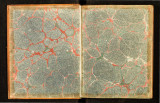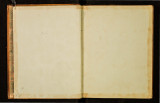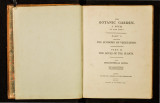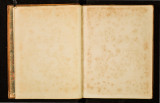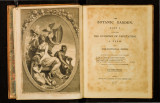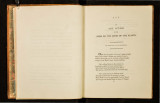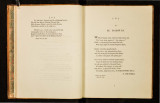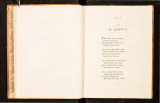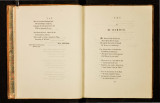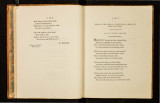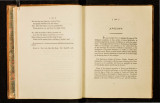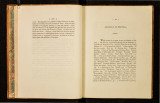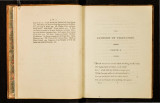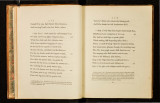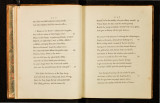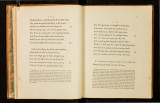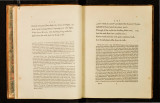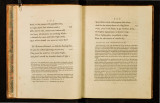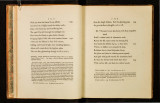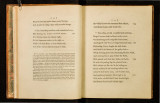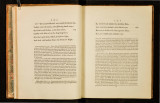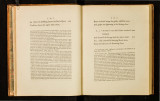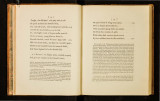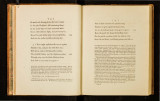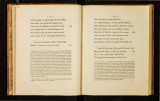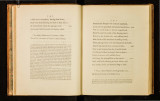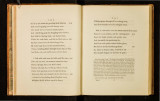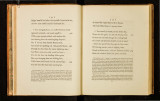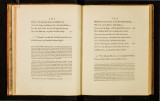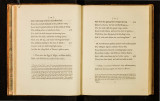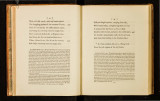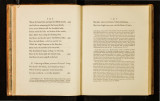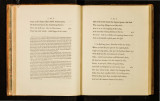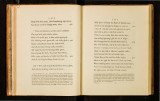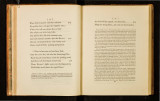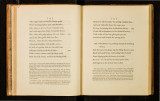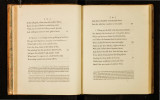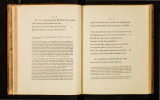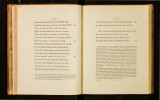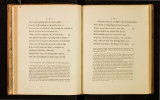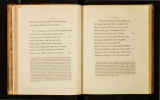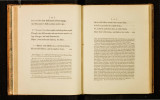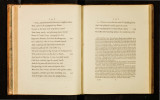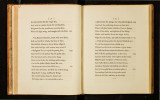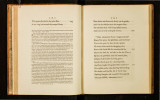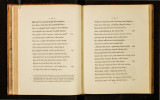| OCR Text |
Show COAL. NoTE XXIII. thick, of a limilarnature to the NewcafHecoal. Phil. Tranf. Abridg. Vol. VI. plate II. p. r92. The fimilitude between the circuml1ances of this colliery, and of the co:1l beneath the fountain of tar above defcribcd, renders it highly probable that this upper thin fe:1m of coal has fufFered a fimihr di(lillation, and that the inflarnmable part of it had either been received into the cby above .in the form of fulphur, wl1ich when burnt in the open air would proclucc alum; or had been dinipated for want of a recci1•e r, where it could be condenfecl. The former opinion is perhaps in this cafe more probable as in lome other coal-beds, of which I have pn cured account~, the furfacc of the coal beneath clunch or clay is of an inferior quality, as at Wefl: Hallum in Nottinghamfhire. The clunch prob:~bly from hence aCCJ1lircs its inflamtmble part, which on calcimtion becomes vitriolic acid. I gathered pieces of clunch converted partially into al11m at a colliery ncar I3ill1on, where the ground was l1ill on nre a few years ago. The heat, which has thus pervaded the beds of morafs, feems to h:~ve been the efFect of the fermentation of their vegetable materials; as new hay fometimes takes fire even in fuch very fmall maffes from the fugar it contains, and fc.:cms hence twt to have been attended with any expulfion of lava, like the deeper craters of volcanos fituated in beds of gr:111ite. 1. The mnrine !hells found in the loofe fand-rock above this refervoir of petroleum, ~nd the coal-beds beneath it, together with the exifl:ence of fea-falt beneath thefe coals, prove that thefe coal-beds have been at the bo!lom of the Jca, during lome remote period of time, and were afterwards raifed into their prefcnt fituation by fubterraneous exp:lnflons of vapour. This doCI:rine is further fupported by the marks of violence, whiclt fomc coal-beds received at the time they were r::tifed out of the fca, as in the collieries at Menclip in Somerfedhire. In thefe there are feven fl:rata of coals, equitant upon each other, with beds of clay and fl:one intervening; amoogfl: which clay are found !hells and fern branches. In one part of this hill the fl:rata are di ~jo ined, and a quantity of heterogeneous fubfl:ances fill up the chafm which disjoins them, on one fide "of thi» chafm the feven fhata of coal are feen correfponding in refpeB: to their reciprocal thicknefs and goodnefs with .the feven fhata on the other fide of the c:1vity, except that they have been elevated feveral yards higher. Phil. Tr:1nf. No. 36o. abridg. Vol. V. p. ?.37· The cracks in the coal-bed near Ticknall in Derbyfhire, and in the fand-fl:one rock over it, in both of which fpecimens of leau-ore and fpar are found, confirm this opinion of their having been forcibly railed up by fubterrancous fires. Over the colliery at Brown-hills near Lich!1eld, there is a fl:ratum of gravel on the fmface of the ground; which may be adduced as another proof to !hew that thole coals had fame time been beneath the fea, or the bed of a river. Ncverthelefs, tht-fe argumen ts only appiy to the c0llieries above mentioned, "hich are few compared with thole which bear no marks of h:.ving been immerfed in the fe:1. On the other hand the production of coals from moraffes, as defcribed .in note XX. is evinced from the vegetable mJtters frequently found in them, and in the flrata over them; as fern-leaves in nodules of iron ore, and from the bog- !hells or frelh water NoTE XXIII. COAL. mufcles fometimes found over them f b I . 6J . ' o ot I wluch I have '""h t I t. I" mens; and IS further proved from ft a ue tcve to be fpeci-r J orne parts of thefe beds b: 1 . IOrme to coal; and the other part fr!l . . el!lg on y tn part tr:Jnr- . 1 retatnJna not only th f, b properties of wood; fpecimens of h" h t> • e orm, ut fomc of the w IC are not unfrequent th - b· procured from Loch Neigh in Ire! d f. B 111 c c .. I nets of the curious, f an ' rom ovey near Exete d h rom a famous cavern called the Tern I f h D . r, an ot er places; and . P eo t e evd, near the tow f AI f. E:onta, at the foot of a mountain cove d . h . . 11 o lor 111 Fran- ! re Wit p111e and favtne in h. I c coa s refembling :recs of ebony. wh· h r r . . ' w lCl are JOund large n. ' lC are IO Jar ffillleraltzcd as t b h pacL ; :l!1J fo to cff!orefcc with pyrites in ( o e eavy and com- ! . nmc parts as to crumble t · _ ot Jer parts wl11te afhes are produced on I . . r . o p tece~ ; yet frum I . h . ca ctnat!On, uom whtchfix I I I" . w llC evtnces their vegetable origin. (D".n R ·r , er. a ca 1 IS procured; b d. J tcr. aiJOnne, art Charbon) T h r c a ueJ another argument from the .1 1 h . . . · o t e1e may I 01 w llC IS dd1dled from 1 .1 ana ogous to vegetable oil and do "fl . coa s, anu which is ' es not ext ( 111 any bo I" t 1 . Chemical DiClionary, art. Bitumen. ues ru Y 1111ltcral. Keir's Wh c nc~ it \vould appear, that though mofl: coli" . . of clay, fand-{!one, and iron Were fo d h Ienes With their attendant {!rata f I . l ' nne on t e places where the vecretable rom w llc 1 tiJey had their origin. yet tl at •I II n· ::. s grew, ' 1 o, ter co ecuons of vegetabl wa01ed down from eminences by c t f . e matter were urren s o waters tnto the b d f . neighbouring feas, nnd "'ere there accumulated at d·ffi . e s o nver>, or the went a gre::tt degree of heat from the" r . '. I .erent penods of time, and under- ' tr 1e1 mentation tn the fam . h of morals which had continued on tl I . I ' e manner as t ofe beds h. r le P all1s w lere they were prodPced A d h b I IS Icrmentation many of them had been . ·r.>d f"· I . . • n t at y . h Jai" Jam tleocean wtth fand and f,> I) 11 ovet t em ; and others from the beds of . . . . l . ea- 1e s F I . . . IIVtiS Wltl accumulations of gra\elupon the to~~ or t ~e ;urpofc of bnngwg this hiflory of th~ products of mora!ll:s more di!linCl% fo c: ~:eo til~ re~dcr, I illali her.e fubjoin two or three accounts of finking or boring r a s, out o a ove twenty whJch I have procured from various l t' rms arc not very intelligible beinr.- the 1 f' h ~ aces, though the . . ' -.. anguage o t e overfeers of coal-works I. lf?httjie/d mille near the Pottery in Staifurdlbire. Soil I .fl t b . 'k 1· .. fllale 4 1 I . h . h oo ' rtc -cay 3 fett • . meta w liC IS ard brown and falls in the weather 4 2 coal 3 . . I 6• , brown gritfl:one 36 I . 1 • • wan ant cay . b ~ r • coa 3-;: . warrant clay 3f· bafs and metal 53i· hard!lone 4· fllaly as 12; coal.'~· warr~nt cl~y, depth unknown. in all about 55 yards. b. 2; Loa~-1/une at ~ljreton tn Detbyfhiye. Soil and clay 7 feet. f,agments of rtone 9 b~nc 1 3· one 6. bmd 3-+· fion.: 5· bind 2. flone 2. bind 10. coal r.!. bind 1 •. l1une .. 111 ~ 7~foft coal 3· bi~<:! 3· ilone 20. bit~d 16. c~al 7f· in all abour 2 61 yards~ 37 " . . 3 bo./Jel CC'CI/-m1ne a/ !Foolarton 111 Nottmghamlhire. Sand and gravel 6 fi t hillel 2I {! {i ee . b. d · one ro. mut or effete coal 1. clunch 4· bind 21. l1one 18. bind 1!). l1one- 111 1 ~· foft. coal 2. clunch ::tnd bind ?.I. coal 7· in all about 48 yards. 4· G:a/. 111111e at fP/>.fl-Hallam in Nottinghamfhite. Soil and clay 7 feet. bind 48. f~tut 1 2· clunch 4· bind 3· Hone 2. hind I. Hone r. bind 3· l1one 1. bind 16. fltJlc: 2 . ~ll~d 12 · fhale 3· clunch, fione, and a bed of cank 54· foft coal 4· clay and dun I lo!t co;~! 4{· clunch and bind 21. coal 1. bro.:d bind :z6. harJ coal 6. in all about 7; }ards. |



